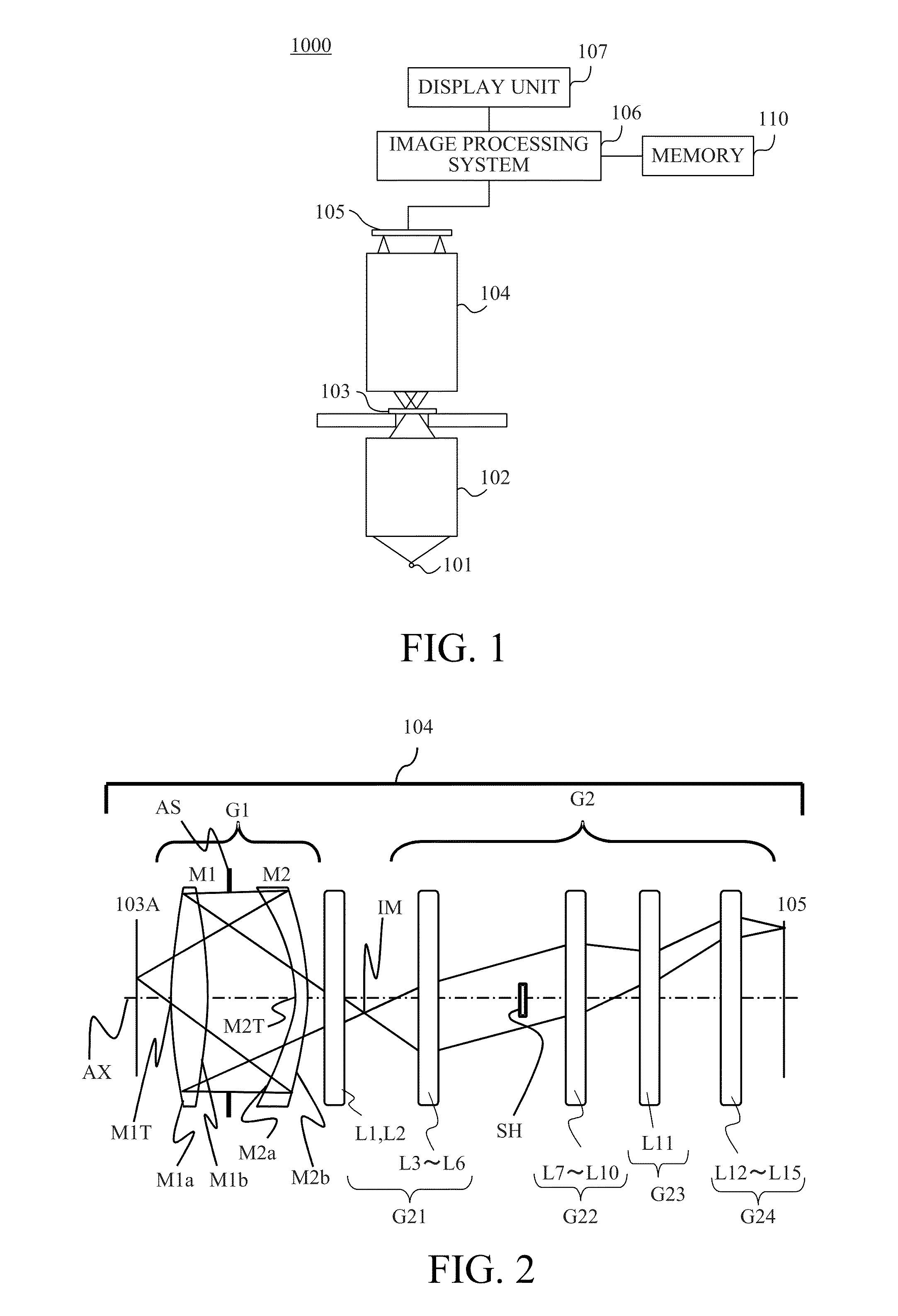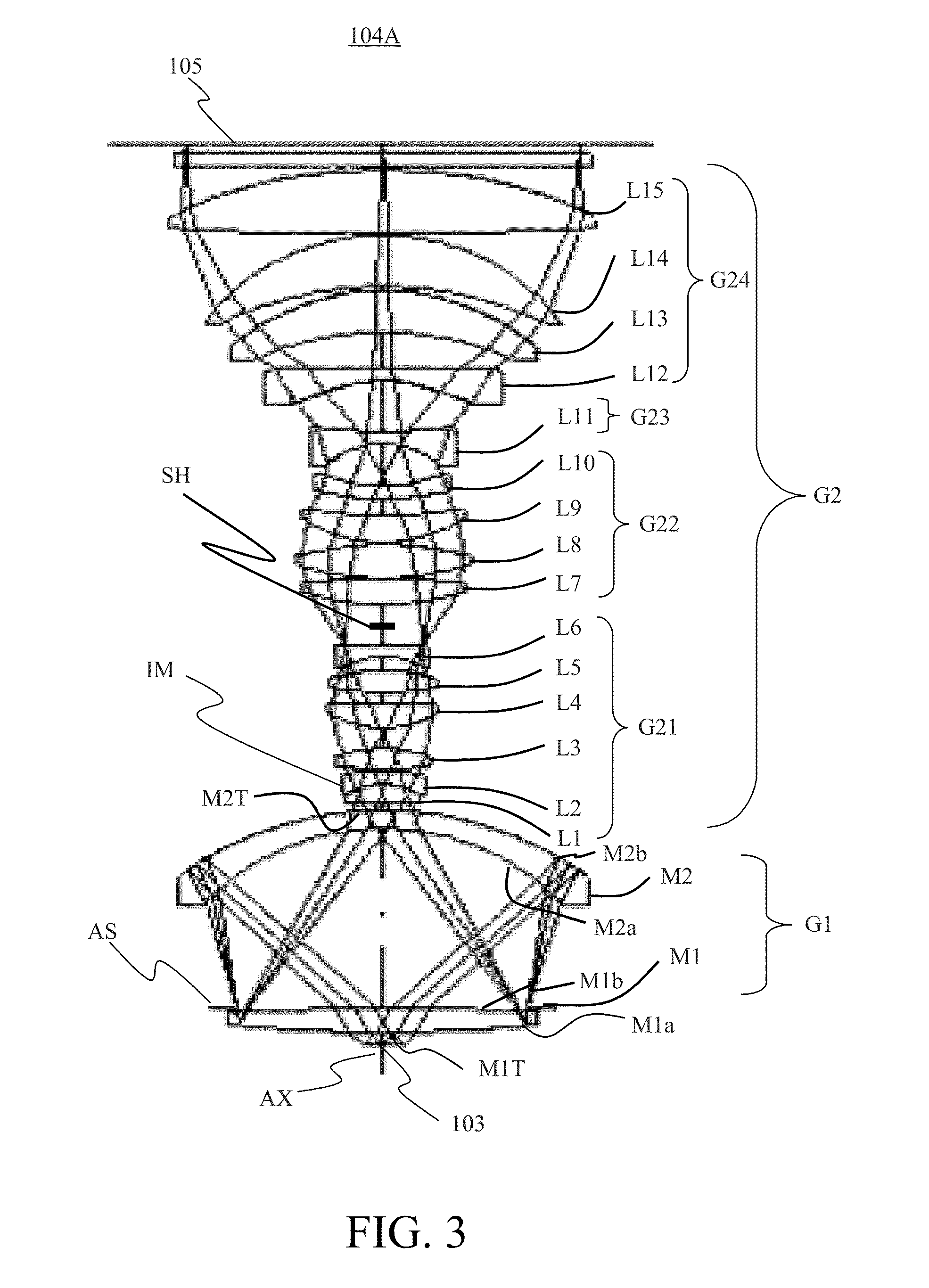Catadioptric system and image pickup apparatus
a catadioptric system and image pickup technology, applied in the field of catadioptric system and image pickup apparatus, can solve the problems of not necessarily providing an observation field of view having a sufficient size, not necessarily providing an image data acquisition through image capture, and requiring a long time. , to achieve the effect of good image side telecentricity, wide wavelength range, and high optical performan
- Summary
- Abstract
- Description
- Claims
- Application Information
AI Technical Summary
Benefits of technology
Problems solved by technology
Method used
Image
Examples
embodiment 1
[0076]In the following description, a specimen (object) side surface of each lens is referred to “as an R1 surface”, and an image sensor (image) side surface of each lens is referred to as “an R2 surface”.
[0077]In Embodiment 1, the R2 surface of the lens L7 in the second lens group G22 is the aspheric surface including the inflexion point. The R2 surface of the lens L7 has a negative optical power on and around the optical axis AX and has a positive refractive power in its peripheral portion, which provides good telecentricity not on the object side, but also on the image side. The ratio of the distance D of the outermost off-axis principal ray from the optical axis AX on the R2 surface of the lens L7 to the maximum image height Ymax is as follows:
D / Ymax=0.094.
[0078]Embodiment 1 thus employs the aspheric surface having the inflexion point as a lens surface on which light fluxes of respective image heights impinge at mutually different positions, thereby enabling provision of good te...
embodiment 2
[0082]In Embodiment 2, the R2 surface of the lens L7 in the second lens group G22 and the R1 surface of the lens L15 in the fourth lens group G24 are the aspheric surfaces each including the inflexion point. Embodiment 2 is different from Embodiment 1 in that two aspheric surfaces each including the inflection point are included. Each of the R2 surface of the lens L7 and the R1 surface of the lens L15 has a negative optical power on and around the optical axis AX and has a positive refractive power in its peripheral portion, which provides good telecentricity not on the object side, but also on the image side.
[0083]The ratio of the distance D (D1) of the outermost off-axis principal ray from the optical axis AX on the R2 surface of the lens L7 to the maximum image height Ymax is as follows:
D1 / Ymax=0.091.
[0084]And, the ratio of the distance D (D2) of the outermost off-axis principal ray from the optical axis AX on the R1 surface of the lens L15 to the maximum image height Ymax is as ...
numerical examples 1
[0093]
25th surface D / Ymax = 0.094SurfaceNo.rdNdνdOBJ5.00 1571.789.371.5264.1 2−3609.2572.99 3−85.687.361.5264.1 4−116.17−7.361.5264.1 5−85.68−72.99 6 (AS)1E+180.00 7−3609.25−9.371.5264.1 8571.789.371.5264.1 9−3609.2572.9910−85.687.361.5264.111−116.173.0012−1000.007.731.6263.313−23.795.001.7432.314−69.260.851580.298.751.6263.316−46.848.351734.989.471.4970.218267.475.1219102.438.851.7535.320−57.485.4721−28.655.001.6236.322−1302.773.2223 (SH)1E+1813.062494.229.741.4970.225872.060.892692.0213.971.7647.827−73.690.502850.2310.911.5961.129150.526.603067.985.261.7627.53148.2317.2332−28.975.001.7444.833384.1020.7234−39.105.001.5264.135−1000.0014.3436−109.2917.241.7444.837−66.981.4938−124.3920.681.7640.139−77.760.50401280.4325.871.6558.641−245.911.50421E+186.001.5264.1431E+183.00IP0.00(Aspheric Coefficients)SurfacekABCDNo.EFGHJ1, 8 0.00E+002.17E−08−7.88E−132.62E−165.08E−20−2.24E−234.77E−27−3.83E−310.00E+000.00E+004, 110.00E+001.56E−081.48E−121.13E−164.86E−211.53E−24−1.25E−281.61E−320.00E+000....
PUM
 Login to View More
Login to View More Abstract
Description
Claims
Application Information
 Login to View More
Login to View More - R&D
- Intellectual Property
- Life Sciences
- Materials
- Tech Scout
- Unparalleled Data Quality
- Higher Quality Content
- 60% Fewer Hallucinations
Browse by: Latest US Patents, China's latest patents, Technical Efficacy Thesaurus, Application Domain, Technology Topic, Popular Technical Reports.
© 2025 PatSnap. All rights reserved.Legal|Privacy policy|Modern Slavery Act Transparency Statement|Sitemap|About US| Contact US: help@patsnap.com



